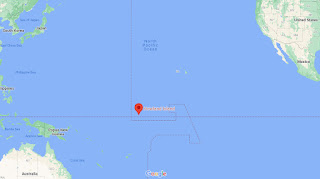View the Index of Unit Histories
"Hell On Wheels"
(Original article written 6/2/08 by Jim Broumley)
The United States Army's 2nd Armored Division, nicknamed "Hell On Wheels," is one of the most storied shoulder patches from World War II. The Second Armored Division's combat history in WWII covered three years, two continents, and ten countries. The 2nd A.D. is remembered by most Cold War veterans for its service at Fort Hood, Texas, with a reinforced brigade forward stationed in West Germany. After participating in the Persian Gulf War, the 2nd Armor Division was deactivated as part of the downsizing of the Army in the 1990s.
The 2nd Armored Division was formed on July 15, 1940, at Fort Benning, Georgia. Then Colonel George S. Patton was in charge of training the new division, and later that year was promoted to Brigadier General and took command. The 2nd AD continued training through 1941 with maneuvers in Tennessee, Louisiana, Texas, and the Carolinas. Reportedly, Patton boasted during these maneuvers that the 2nd Armored Division would be "Hell on Wheels" when it met the enemy. The moniker stuck and became the Division's nickname and part of the unit shoulder sleeve insignia.
The 2nd Armored Division was organized as a "heavy" armored division that had two armored regiments of four medium tank battalions and two light tank battalions. The heavy division also maintained an "armored infantry regiment" organization. Hell On Wheels and the 3rd Armored Division kept this structure throughout the war; while the army's other 14 armored divisions were reorganized as "light" armored divisions.
The core units of 2AD were the 41st Armored Infantry Regiment, the 66th Armored Regiment, the 67th Armored Regiment, the 17th Armored Engineer Battalion, the 82nd Armored Reconnaissance Battalion, and the 142nd Armored Signal Company. The 2d Armored Division Artillery was composed of the 14th, 78th, and 92nd Armored Field Artillery Battalions. However, there was a variety of attachments throughout the war.
Some elements of the 2nd Armored Division saw combat for the first time when Allied Forces landed at Casablanca, in North Africa, on November 8, 1942. However, the Division as a whole did not enter combat until the invasion of Sicily on July 10, 1943. The Hell On Wheels Division saw action at Butera, Campobello, and through to Palermo. During the fight for Sicily, the 2nd AD fought against the German's elite Hermann Göring Panzer Division. In November of 1943, the 2nd Armored Division was moved to England to train for the invasion of Europe, Operation Overlord.
The 2AD was landed on Omaha Beach in Normandy on D-day plus 3, June 9, 1944. Hell On Wheels raced across France with the rest of the Third Army during July and August. The Division reached the Albert Canal in Belgium on September 8, 1944, and crossed the German border north of Schimmert on September 18, 1944. On October 3, 1944, the 2nd Armor attacked the Siegfried Line, breached it, and then crossed the Wurm River, seized Puffendorf on November 16th, and Barmen on November 28th. The 2d Armor Division was holding positions on the Roer River when ordered to help contain the German's Ardennes offensive, the Battle of the Bulge.
During the Battle of the Bulge, Hell On Wheels fought in eastern Belgium, blunting the German Fifth Panzer Army's penetration of American lines. The Division helped reduce the Bulge in January, fighting in the Ardennes forest in deep snow and freezing winter conditions. After a rest in February, the Division drove on across the 1,153-foot wide Rhine River on March 27, 1945, in an unprecedented seven hours while under mortar fire. On April 11, 1945, the 2nd Armored Division was the first American Division to reach the Elbe River. On orders, the Division halted on the Elbe. In July 2nd A.D. was the first American unit to enter the German capital city of Berlin.
During World War II, Hell On Wheels took 94,151 prisoners of war, liberated 22,538 Allied prisoners of war, shot down or damaged on the ground 266 enemy aircraft, and destroyed or captured uncountable thousands of enemy tanks and other equipment and supplies. 2nd Armored Division soldiers had been awarded 9,369 awards for distinguished service and bravery including two Medals of Honor, twenty-three Distinguished Service Crosses, two thousand three hundred two Silver Stars, and not to mention nearly six thousand Purple Hearts. In 238 battle days, the 2nd Armored suffered 7,348 casualties, including 1,160 killed in action. After a brief period of occupation duty, the 2nd Armored Division returned to Fort Hood, Texas in 1946.
Based at Fort Hood, the 2nd Armored Division furnished thousands of trained replacements to units serving in the Korean War. In 1951 the Hell on Wheels division returned to Germany to serve for six years in support of the North Atlantic Treaty Organization (NATO), and then returned to Fort Hood. The 1/50 Infantry; 2/1 Cavalry; 1/40 Field Artillery; and 1/92 Field Artillery fought in the war in Vietnam, but not the Division as a whole. The main division, however, would spend much of the next 35 years at Fort Hood.
During the Cold War, the 2nd Armored Division's primary mission was to prepare to conduct heavy armored combat against Warsaw Pact forces in defense of NATO. Hell On Wheels formed a key component of the U.S. military's plan to move "ten divisions in ten days" to Europe in the event of a Soviet threat to NATO. The division practiced this task numerous times during Exercise REFORGER (Return of Forces to Germany) from 1967 to 1988. To build and maintain combat skills, the division's maneuver brigades deployed almost annually to the National Training Center at Fort Irwin, California, to face an opposing force modeling Soviet military weapons and tactics.
In 1978 the 2nd Armored Division's 3rd Brigade deployed to the Federal Republic of Germany and was assigned to NATO's Northern Army Group (NORTHAG). The 3rd Brigade received additional aviation, engineer, military intelligence, medical, and logistics support units. Now designated as the 2nd Armored Division (Forward), the unit was based at a new military facility near the village of Garlstedt just north of the city of Bremen. The unit's primary mission in the event of conflict with the Warsaw Pact was to either secure airfields or staging areas for the deployment of III Corps from the United States or to deploy directly to the Inter-German Border (IGB) and establish a blocking position as part of a NATO combat force. However, with the end of the Cold War, the U.S. military began to draw down its combat units. The 2nd Armored Division was scheduled to be inactivated in the spring of 1990.
The invasion of Kuwait by Saddam Hussein in August 1990 caught the division in the midst of the post-Cold War drawdown of the U.S. military. On October 10, 1990, the division began to deploy more than 5,000 soldiers to Saudi Arabia to participate in Operations Desert Shield and Desert Storm. The 2nd Armored Division's Second Brigade could not be deployed as it was in the middle of deactivating. The Division's 1st Brigade deployed to Saudi Arabia independently and participated in Operation Desert Storm by providing heavy armor for USMC forces in their attack into Kuwait. The 3rd Brigade - 2nd Armored Division (Forward) - based in Germany, conducted combat operations as the third maneuver brigade of the 1st Infantry Division from Fort Riley, Kansas. On February 24, 1991, the Second Armored entered Iraqi-held Kuwait. In 100 hours Allied Forces had taken back the country of Kuwait and defeated the Iraqi Army.
Between the cease-fire and the official end of the war in April 1991, the 2nd Armored Division (Forward) took part in security operations to ensure peace in Kuwait. Hell On Wheels then redeployed to Saudi Arabia where some of its soldiers established and ran three refugee camps near Raffia, Saudi Arabia. Division relief workers processed over 22,000 Iraqi refugees between April 15 and May 10, 1991.
Desert Storm had temporarily interrupted the inactivation of the division that had begun in 1990. However, after the Persian Gulf War, the 2nd Armored Division went through a confusing series of deactivations and re-designations. The 1st Brigade returned to Fort Hood and was re-designated the 3rd Brigade, 1st Cavalry Division. On September 1, 1991, the 2nd Armored Division (Forward) officially became the 2nd Armored Division (-). Over the summer and fall of 1992, the 2nd Armored Division (-) was inactivated. In 1992, the 5th Infantry Division (Mechanized) at Fort Polk, Louisiana was re-designated the 2nd Armored Division. In 1993 that unit moved to Fort Hood. In December 1995 the 2nd A.D. was again re-designated, this time as the 4th Infantry Division. This ended more than 55 years of continuous active duty for the "Hell On Wheels" Division.
View the Index of Unit Histories
 Last week (September 17th) was the 161st
anniversary of the Battle of Antietam. We have visited many times. Antietam, located
next to the small town of Sharpsburg, Maryland, is my favorite Civil War battlefield.
Antietam has historical significance in that the battle has a combined casualty
count of 22,727 killed, wounded, and missing. That makes Antietam (or
Sharpsburg to the Confederates) the highest one-day casualty count in American
military history. It was the impetus for Abraham Lincoln’s Emancipation
Proclamation, which changed the Federal cause for fighting the war from
preserving the Union to ending slavery. Moreover, it is an easy battlefield to
view the terrain and understand the flow of the battle. Climb the observation
tower. It’s worth it. And finally, the battlefield park is more than a park or
a tourist attraction. It’s hallowed ground where thousands of Americans fought
and died. That being said, Antietam is also a beautiful place to go for a walk and enjoy
the fall weather.
Last week (September 17th) was the 161st
anniversary of the Battle of Antietam. We have visited many times. Antietam, located
next to the small town of Sharpsburg, Maryland, is my favorite Civil War battlefield.
Antietam has historical significance in that the battle has a combined casualty
count of 22,727 killed, wounded, and missing. That makes Antietam (or
Sharpsburg to the Confederates) the highest one-day casualty count in American
military history. It was the impetus for Abraham Lincoln’s Emancipation
Proclamation, which changed the Federal cause for fighting the war from
preserving the Union to ending slavery. Moreover, it is an easy battlefield to
view the terrain and understand the flow of the battle. Climb the observation
tower. It’s worth it. And finally, the battlefield park is more than a park or
a tourist attraction. It’s hallowed ground where thousands of Americans fought
and died. That being said, Antietam is also a beautiful place to go for a walk and enjoy
the fall weather.Enjoy some pictures of the battlefield from our trip last Wednesday.
If you are looking for background on the Battle of Antietam, I have “Landscape Turned Red: The Battle of Antietam” by Stephen Sears on my shelf. Get out and
enjoy a historic site while the weather is nice. Maybe I’ll see you at Valley
Forge next week. 😉












